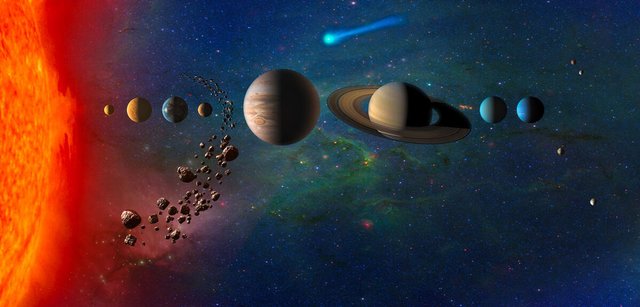NASA confirmed the existence of a new planet in the Solar System/NASA confirmó la existencia de un nuevo planeta en el Sistema Solar

Source
I suppose you have all read or heard about "Planet X", this term was used since the 19th century to refer to a possible unknown planet beyond Neptune that would explain gravitational anomalies in the orbits of Uranus and Neptune. However, many of these anomalies were resolved with the precision of the calculations of the mass of Neptune.
Supongo que todos habréis leído o escuchado hablar del "Planeta X", este término se usó desde el siglo XIX para referirse a un posible planeta desconocido más allá de Neptuno que explicara anomalías gravitacionales en las órbitas de Urano y Neptuno. Sin embargo, muchas de estas anomalías se resolvieron con la precisión en los cálculos de la masa de Neptuno.
Recently, NASA announced the discovery of a new planet in the outer reaches of the Solar System, beyond the orbit of Neptune, led by astrophysicist Konstantin Batygin of the California Institute of Technology. The discovery of this new planet, still without an official name, could change the way we understand the Solar System and its most remote reaches, representing a significant advance in the field of astronomy.
Recientemente, la NASA ha anunciado el descubrimiento de un nuevo planeta en los confines del Sistema Solar, más allá de la órbita de Neptuno, liderado por el astrofísico Konstantin Batygin, del Instituto de Tecnología de California. El descubrimiento de este nuevo planeta, aún sin nombre oficial, podría cambiar la forma en que entendemos el Sistema Solar y sus confines más remotos, representando un avance significativo en el campo de la astronomía.

Source
The main evidence is based on the unusual orbits of certain trans-Neptunian objects (TNOs). These objects, beyond Neptune, appear to be gravitationally influenced by a massive celestial body not yet observed. This hypothetical planet is estimated to be an ice giant located at a considerable distance from the Sun and possesses an estimated mass between 5 and 10 times that of the Earth.
La principal evidencia se basa en las órbitas inusuales de ciertos objetos transneptunianos (TNOs). Estos objetos, más allá de Neptuno, parecen ser influenciados gravitacionalmente por un cuerpo celeste masivo aún no observado. Se estima que este hipotético planeta es un gigante helado que se encuentra a una distancia considerable del Sol y posee una masa estimada entre 5 y 10 veces la de la Tierra.
Despite simulations and calculations, this planet has not yet been observed directly. Its great distance and relatively low brightness make it difficult to detect with current telescopes. However, if the existence of this planet is confirmed, it would mean a revision of our models on the formation and evolution of the Solar System and would open new questions about the diversity of planetary systems and the possibility of finding life elsewhere in the universe.
A pesar de las simulaciones y cálculos, este planeta aún no ha sido observado directamente. Su gran distancia y el brillo relativamente bajo lo hacen difícil de detectar con los telescopios actuales pero, si se confirma la existencia de este planeta, significaría una revisión de nuestros modelos sobre la formación y evolución del Sistema Solar y abriría nuevas preguntas sobre la diversidad de sistemas planetarios y sobre la posibilidad de encontrar vida en otros lugares del universo.

Source
But will we ever be able to spot this planet with a telescope? There are several significant challenges that make it difficult to detect. First, Planet Nine is estimated to be between 400 and 800 astronomical units (AU) from the Sun (1 AU = Earth-Sun distance). This means that it is incredibly faint and difficult to observe even with advanced telescopes.
Pero, ¿podremos algún día detectar este planeta con un telescopio?. Existen varios desafíos significativos que hacen que su detección sea complicada, por un lado se estima que el Planeta Nueve está entre 400 y 800 unidades astronómicas (UA) del Sol (1 UA = distancia Tierra-Sol). Esto significa que es increíblemente tenue y difícil de observar incluso con telescopios avanzados.
On the other hand, although it is several times more massive than Earth, its relatively small size and distance mean that it reflects very little sunlight. This makes it an extremely faint object in terms of luminosity. Its hypothesized orbit is highly elliptical and its exact location in the sky is uncertain, meaning that astronomers have to scan a very wide region of the sky to look for it. So, for now, we'll have to wait and see.
Por otro lado, aunque es varias veces más masivo que la Tierra, su tamaño relativamente pequeño y su distancia hacen que refleje muy poca luz solar. Esto lo convierte en un objeto extremadamente débil en términos de luminosidad. Su órbita hipotética es altamente elíptica y su ubicación exacta en el cielo es incierta, lo que significa que los astrónomos tienen que rastrear una región muy amplia del cielo para buscarlo. Así que, por el momento, habrá que esperar.
More information/Más información
https://science.nasa.gov/solar-system/planet-x/
This is a good news. Whenever I come across NASA post, I am so sure that there is a new update that is coming up and which will benefit the world of humanity. Thank you for sharing this
Hi, @mauromar,
Your post has been manually curated!
Seguramente existente otros planetas del Sistema Solar, en la inmensidad astronómica del Universo todo es posible. No nos alcanzaría la vida para saberlo.
Gracias por compartir. Saludos y bendiciones.